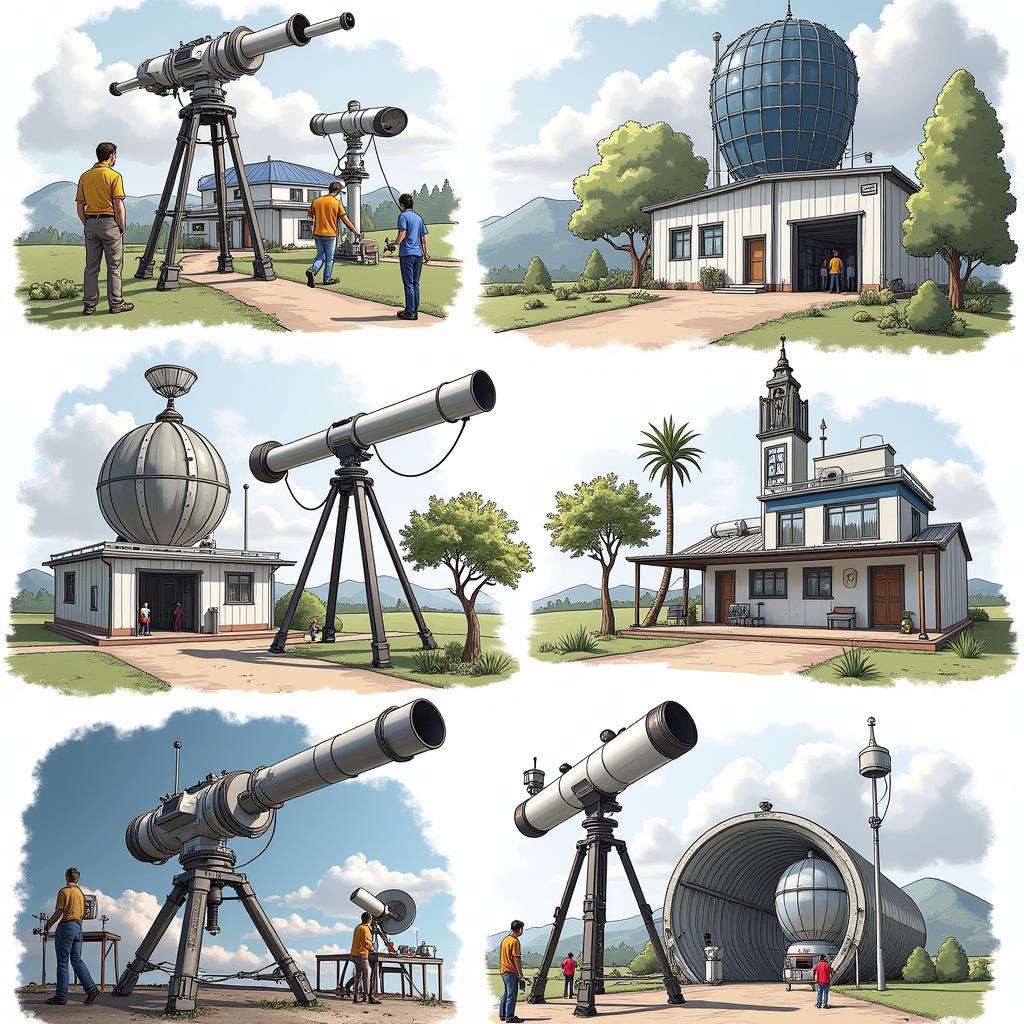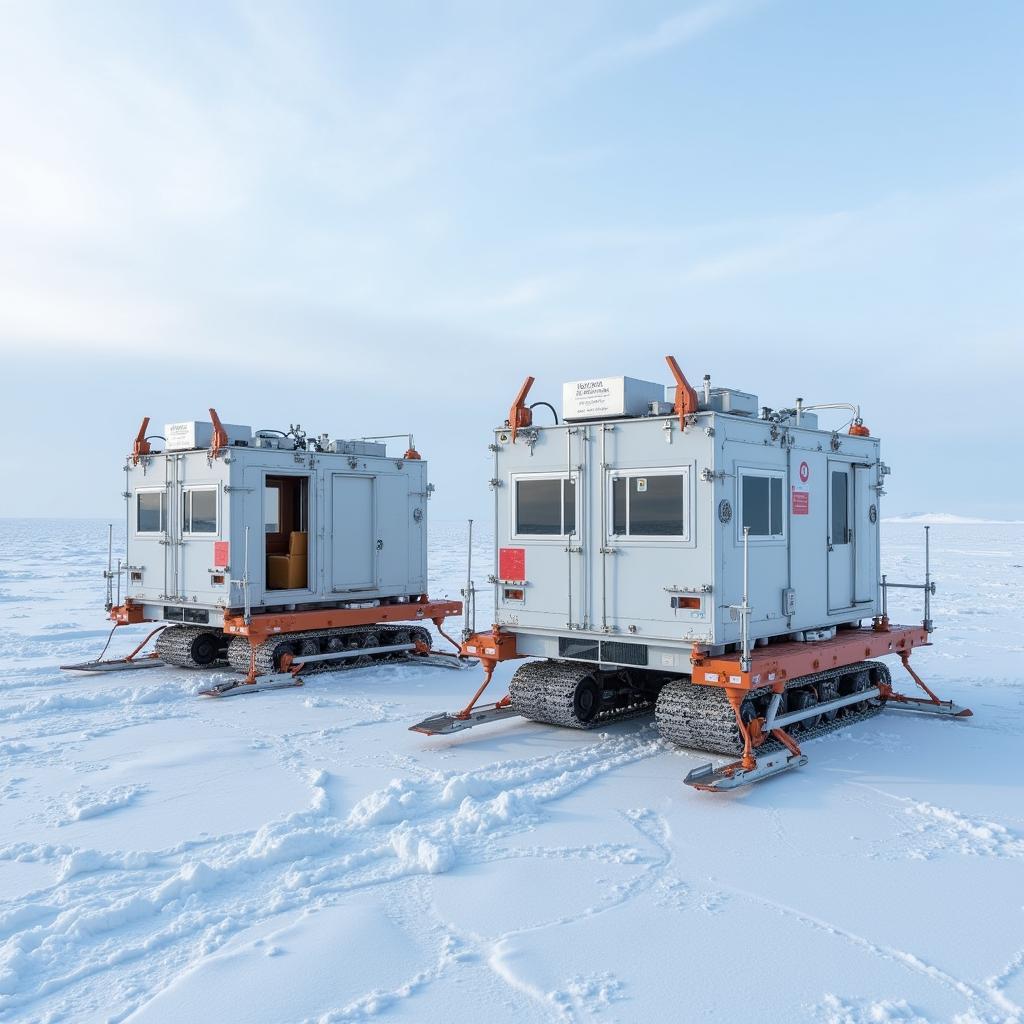Halley Research Station In Antarctica, a name synonymous with scientific discovery and extreme resilience, holds a unique place in the annals of polar exploration. This remote outpost, perched on the Brunt Ice Shelf, serves as a vital hub for atmospheric and space weather research, offering unparalleled insights into Earth’s climate and the cosmos. But beyond its scientific significance, Halley VI Research Station carries an aura of mystery, sparking curiosity about its operations and the challenges of life in this isolated, frozen realm.
A Beacon of Science in a Frozen Wasteland: Exploring Halley Research Station
Halley VI Research Station, unlike any other research facility, is designed to withstand the harshest conditions on Earth. From its innovative modular design enabling relocation to its crucial role in discovering the ozone hole, Halley holds a special place in Antarctic history. But what exactly goes on within its walls? What mysteries does this icy outpost conceal?
The Science Behind the Ice: Research at Halley VI Research Station
The primary focus of research at Halley Research Station revolves around understanding the Earth’s atmosphere and near-space environment. Scientists here study a range of phenomena, from the aurora australis to ozone depletion, and gather crucial data that contributes to global climate models. The station also plays a vital role in monitoring space weather, which can affect satellite communications and power grids.
 Halley VI Research Station scientific equipment and research activities in Antarctica
Halley VI Research Station scientific equipment and research activities in Antarctica
Life on the Edge: The Challenges of Antarctic Living
Life at Halley Research Station presents unique challenges. The extreme cold, prolonged darkness during winter, and the constant threat of blizzards create a demanding environment. The isolation also takes a toll, requiring residents to be self-sufficient and adaptable. But despite these hardships, the unique experience and the camaraderie forged in this unforgiving landscape create a strong bond among the station’s inhabitants.
What Makes Halley VI Research Station Unique? A Look into its Design and History
Halley VI Research Station is not a static structure; it’s a marvel of engineering designed to move. Its modular design allows the station to be relocated periodically, a crucial feature given the dynamic nature of the Brunt Ice Shelf. This adaptability has proven essential in the face of calving events and shifting ice conditions.
The Modular Marvel: Halley VI’s Innovative Architecture
The modular design of Halley VI Research Station allows it to be raised hydraulically on skis and towed across the ice shelf to a new location. This innovative design ensures the station’s longevity and allows it to adapt to the ever-changing Antarctic landscape. This remarkable feat of engineering sets Halley apart from other research stations and allows for continued scientific observation in this critical region.
 Halley VI Research Station's unique modular design on skis in Antarctica
Halley VI Research Station's unique modular design on skis in Antarctica
A Legacy of Discovery: Halley’s Contribution to Science
Halley Research Station has a long and distinguished history of scientific discovery. Perhaps its most significant contribution was the discovery of the ozone hole in 1985, a finding that led to international agreements to protect the ozone layer. This groundbreaking research solidified Halley’s place as a crucial scientific outpost and highlighted the importance of continued observation and study in Antarctica.
“The data collected at Halley is instrumental in understanding global climate change,” states Dr. Amelia Carter, a glaciologist with extensive experience in Antarctic research. “Its location provides a unique vantage point for observing crucial atmospheric processes.”
Surviving the Winter: The Human Element at Halley
Wintering at Halley VI Research Station is an experience like no other. The long polar night, lasting for months, tests the resilience of even the most seasoned Antarctic veterans. The close-knit community and the shared challenges create a unique bond, fostering a sense of camaraderie that is essential for surviving the harsh conditions.
“The winter months at Halley are a testament to human adaptability,” comments Professor David Miller, a psychologist specializing in the effects of isolation. “The resilience and resourcefulness displayed by the wintering teams are truly remarkable.”
 Halley VI Research Station during the Antarctic winter
Halley VI Research Station during the Antarctic winter
The Future of Halley Research Station: Continued Exploration in a Changing World
Halley VI Research Station continues to play a critical role in advancing our understanding of the Earth’s climate and the universe beyond. Its innovative design, coupled with the dedication of the scientists and support staff, ensures that this vital outpost will continue to provide invaluable data for years to come. Halley Research Station stands as a beacon of human ingenuity and perseverance in the face of extraordinary challenges, pushing the boundaries of scientific exploration in one of the most remote and extreme environments on Earth.
Halley Research Station in Antarctica, a symbol of scientific endeavor and human resilience, continues to unlock the secrets of our planet. From its vital research to its unique design, Halley VI Research Station stands as a testament to our quest for knowledge and our ability to thrive in the most challenging environments.
FAQ
- What is the purpose of Halley Research Station? (Answer: Research on Earth’s atmosphere, space weather, and climate change).
- Where is Halley VI Research Station located? (Answer: On the Brunt Ice Shelf in Antarctica).
- What is unique about Halley VI’s design? (Answer: Its modular design allows it to be relocated).
- What major discovery was made at Halley? (Answer: The discovery of the ozone hole).
- What are the challenges of living at Halley? (Answer: Extreme cold, isolation, and prolonged darkness).
For further assistance, please contact us at Phone Number: 0904826292, Email: [email protected] Or visit us at: No. 31, Alley 142/7, P. Phú Viên, Bồ Đề, Long Biên, Hà Nội, Việt Nam. We have a 24/7 customer support team.